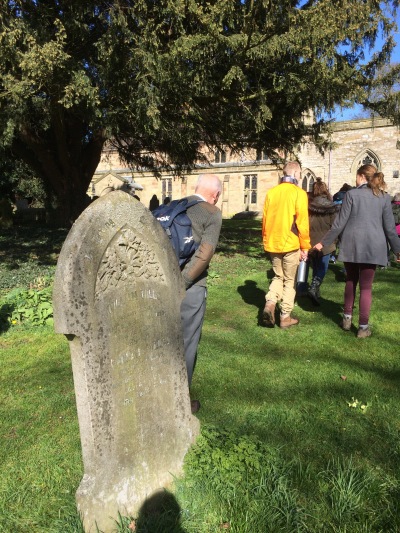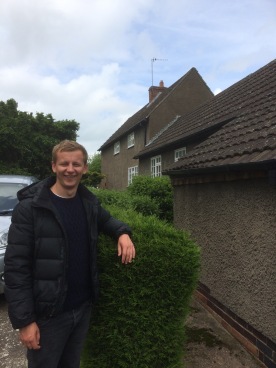Remember the WDYTYA when Mark Gatiss discovered his ancestral home in Ireland? “Wonderful to find something as tangible as this… a homestead.” Don’t you think every family historian should have that ‘homestead moment’?
We recently took a friend walkabout in our (non-identical) ‘twin’ villages of East and West Leake. A little online research using Ancestry and Findmypast had unexpectedly revealed that one of his family lines hailed from our village. The Mills family had established the local industry of basket weaving 200 years ago. On our Good Friday Perambulation of the Church of England Benefice – an enjoyable community walk of more than 20 miles – we noticed a cluster of Mills family graves in West Leake churchyard.

So I phoned Mike Saunders of the East Leake and District Local History Society to ask if he knew which was the Mills family home. Metaphorical red carpet rolled out, we were met in the Churchyard Lych Gate and Mike showed us the churchyard plan so that we missed none of the couple of dozen family graves. And he told us that his Society is planning to put a blue plaque on the cottage where Edward Mills set up the first basket works in the village. It used to double-up as an alehouse under the sign of The Basket. But there’s no sign at the moment, so without Mike’s help we would have walked by without giving Edward’s descendant his ‘homestead moment’.

I am often asked to find family homes, usually by descendants of ancestors who ‘flew the nest’ and emigrated to America, Canada, Australia, Southern Africa or New Zealand. You might expect this to be easy in the 19th century, but Census Enumerators in rural settlements often failed to record house names or numbers. This deficiency might be made up by reference to parish rate books, Tithe Apportionment Maps and Schedules, or a painstaking re-enactment of the enumerator’s route through the village. But what if the emigrant sailed before 1841? Or in the 18th or even 17th century?
The Gambles now live in British Columbia. The surname is probably the Old Norse nickname Gamal, meaning ‘old’. Art Gamble’s line comes from Derbyshire. He asked me if I could find his ancestral home. Thomas Gamble had paid Land Tax for property in Idridgehay in 1798, and his ancestor Ralph Gamble’s house and land in ‘Edridghaie’ were described in a Duchy of Lancaster Survey Book of the mid 17th century:

But where exactly was this Gamble family home? I concluded that the family had sold up (or perhaps the property had been left to a daughter) before the earliest mapping of ownerships by the early Victorian Tithe Surveyors.
There was no single source that would answer this question, so I looked at everything in the Derbyshire Archives that related to land in Idridgehay – deeds, glebe terriers, sales particulars, etcetera etcetera etcetera. Nothing. My breakthrough finally came from the 1773 Inclosure Award of Hulland Ward – a township adjacent to Idridgehay [Derbyshire Archives Q/RI/54a]:
We do also award set out and Allott unto the said John Gamble in Right of his Estate in the said Parish or Township of Turnditch one piece or parcel of Land No 57 in the said Plan containing two acres two Roods and four perches or thereabouts bounded by the Allottment No 74 the said Ashborne Road and the allottments No 64 212 177 and 211 And we do order direct and appoint that the Mounds or Fences for inclosing the said allottment against the said Allottment No 74 and the said Ashborne Road shall be made and for ever hereafter repaired and mainteained by the said John Gamble or the Owners of the said Allottment for the time being
The map clearly showed this parcel, but it wasn’t a ‘homestead’, just a small field that had previously been common pasture. Notice the wording however – ‘in right of his Estate in … Turnditch’. So the two and a half acres beside the Ashbourne Road were additional to other land which John Gamble already owned – and perhaps this was the family home. What source might reveal this link? Lloyd George’s Domesday, in my opinion, was our best hope. Following Lloyd George’s 1909-10 Finance Act, a tax was to be levied on the appreciation of land values, and a necessary precondition was to survey the whole of the British Isles and record ownerships and property values.
D595R/4/1/58 is the Derbyshire Archives reference of the Hulland Ward “Domesday Book” of 1910 and the Land Valuation map including the Gamble allotment is the 25-inch Ordnance Survey sheet Derbyshire 44.2, Derbyshire Record Office reference D595R/4/2/264. The map showed clearly and unchanged the 1773 allotment 57 but it was now labelled “Part 146”, 146 being a hereditament number in the Survey Book. It was therefore, as I had predicted, co-owned with a larger holding. The same number and colouring was on a Farmhouse and surrounding land at the bottom of this map.

According to the survey book the Occupier was Wm Langdon and the Owners the Executors of G T White represented by Mrs White at Kirk Langley. The description was “House, buildings & land in Mercaston Lane”. The land measured 33 acres 36 perches, the house 6 perches, & buildings 1 rood 3 perches. I drove back from the archives past this house and photographed it.

Not perhaps, ‘beyond reasonable doubt’, but this is about as good as such evidence gets for want of contemporary maps.
Success is not guaranteed. One of my first freelance commissions was to attempt to discover the Old World home of the Reverend John Robinson, the first Pastor of the Pilgrim Fathers before the Mayflower sailed. I did discover new evidence of the land his family tilled at Sturton-le-Steeple, but I had to conclude that it was impossible to prove or to disprove the local tradition linking the Robinsons with a cottage just outside the village now known as Crossways.
peter@peterfoden.com

I believe we should all have our ‘sacred space’ away from it all!
LikeLike
Yes, and it doesn’t have to be a family home. Having that ‘ancestral place’ is a luxury many can never have in a world on the move. Going back may never be possible, but discovering that our ancestors were led through crises, and found new homes when their old ones were lost to them, might help us to empathise with the many facing similar disruptions right now. And the ‘old homestead’ is of course for Christians a faint reflection of the City or the Kingdom to which we belong by Adoption.
LikeLike